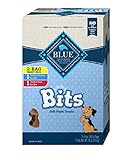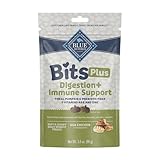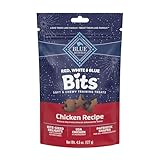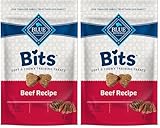If you’ve landed here after Googling “Blue Bits dog treats recall,” take a deep breath—you’re not alone, and you’re not overreacting. When a popular brand hits the headlines for the wrong reasons, every dog parent in the training-treat aisle suddenly feels the floor tilt. The good news? The recall spotlight is also a chance to level-up your treat standards, learn exactly what “soft” and “safe” should mean in 2025, and walk away with a mental checklist that works for any pouch, bin, or subscription box you encounter from now on.
Below, we’ll unpack why the recall happened, how regulatory oversight is evolving, and which science-backed attributes separate the truly gentle training tidbits from the merely cute marketing. You won’t find a ranked “top 10 list” here—those change faster than a puppy’s attention span. Instead, you’ll get the evergreen know-how to judge every soft treat you see this year (and next) with the cool confidence of a canine nutrition insider.
Top 10 Blue Bits Dog Treats Recall
Detailed Product Reviews
1. Blue Buffalo Bits Soft Dog Treats for Training, Made With Natural Ingredients & Enhanced with DHA, Chicken Recipe, 19-oz Bag

Overview: Blue Buffalo Bits Soft Dog Treats deliver a 19-oz stash of tender, chicken-first morsels engineered for repetitive training. Each piece is sized for rapid rewarding, so you can keep momentum in puppy class or agility drills without overfeeding.
What Makes It Stand Out: The inclusion of DHA from fish oil turns an everyday treat into a brain-boosting snack—rare at this price point. The soft, moist texture works for seniors, puppies, and toy breeds that struggle with crunchy biscuits, yet the pieces still break cleanly in your pocket.
Value for Money: At roughly 79 ¢ per ounce you get 475+ treats, undercutting boutique brands by 25 % while still excluding fillers like corn, wheat, soy, and artificial dyes. A resealable bag keeps the last bite as soft as the first, so nothing ends up in the trash.
Strengths and Weaknesses:
Pros: real chicken first, DHA for cognition, generous count, stays soft for weeks.
Cons: contains chicken meal (some dogs react), modest odor that transfers to hands, 4 kcal per piece adds up during marathon sessions.
Bottom Line: For owners who burn through rewards daily, this big-bag option balances nutrition, palatability, and budget better than anything on the big-box shelf. Stock it.
2. Blue Buffalo Wilderness Wild Bits Soft & Chewy Training Treats for Dogs, Grain-Free, Chicken Recipe, 10-oz. Bag

Overview: Blue Wilderness Wild Bits shrink the classic Blue formula into a grain-free, 10-oz pouch aimed at dogs with ancestral cravings. The higher protein profile mirrors the brand’s Wilderness kibble line, creating flavor harmony for pups already on that diet.
What Makes It Stand Out: Grain-free isn’t just marketing here—there’s zero corn, wheat, soy, or gluten meals, making it safe for many allergy sufferers. Added omega-3 & 6 fatty acids support coat gloss, while DHA still sneaks in for neural health, features often reserved for puppy-specific SKUs.
Value for Money: At $1 per ounce it’s pricier than regular Bits, but you’re paying for meat-dense formulation and allergen safety. The 10-oz size is travel-friendly; you won’t feel guilty tossing half a bag because it hardened—reseal and finish within a month.
Strengths and Weaknesses:
Pros: high chicken content, grain-free, small calorie load (2 kcal), soft for older jaws.
Cons: bag empties fast with big breeds, strong aroma, some batches arrive overly dry.
Bottom Line: If your dog itches after wheat-based snacks or you need a trail-worthy grain-free motivator, Wild Bits justify the premium. Otherwise, stick with the classic line.
3. Blue Buffalo Blue Bits Natural Soft-Moist Training Dog Treats Variety Pack 2 Flavors ( 11 OZ Each Bag ) 22 OZ Total.

Overview: Blue Buffalo’s Variety Pack bundles two 11-oz bags—usually chicken and beef—of their flagship soft-moist Bits, giving 22 oz total for multi-dog households or picky trainers who rotate flavors to maintain interest.
What Makes It Stand Out: Rotation combats “treat fatigue” without switching brands, keeping digestive systems stable. Each recipe mirrors the parent line: real meat first, DHA, no poultry by-product meals, corn, wheat, or soy, so you’re not downgrading for variety’s sake.
Value for Money: At $1.36 per ounce it’s the costliest Bits configuration, but you’re effectively buying two medium bags that would retail separately for ~$28. The dual zip-locks extend freshness, and the cardboard sleeve prevents warehouse-crushed crumbs.
Strengths and Weaknesses:
Pros: flavor variety, same clean ingredient list, large total volume, ideal for fosters or multi-pet homes.
Cons: higher up-front price, occasional flavor imbalance (one bag may be near expiry), bulk requires pantry space.
Bottom Line: For trainers who juggle several dogs or need a long-lasting stash that won’t bore taste buds, the variety pack is convenient and still cheaper than boutique single-flavor bags. Buy once, reward for months.
4. Blue Buffalo Blue Bits Plus Skin & Coat and Immune Support Daily Benefit Dog Treats, Soft & Chewy Salmon Morsels, 3.5-oz. Bag

Overview: Blue Bits Plus pivot from basic training bites to functional wellness, infusing salmon-based morsels with pumpkin, prebiotic fiber, vitamin E, and zinc to target digestion, skin, coat, and immunity in a 3.5-oz pouch.
What Makes It Stand Out: Functional treats usually come in crunchy dental form; delivering digestive and immune support via a soft, 2-kcal bit means even toothless pups get daily benefits. Salmon provides novel protein for chicken-sensitive dogs, yet USA chicken is still included to keep palatability sky-high.
Value for Money: At $22.77 per pound this is Blue’s most expensive Bits line, but you’re paying for micronutrient fortification comparable to veterinary brands costing 30 % more. Portion control is built-in—only 80 treats per bag prevent over-supplementation.
Strengths and Weaknesses:
Pros: dual protein, added fiber for gut health, tiny size great for puppies, no corn/wheat/soy.
Cons: tiny bag drains fast, fishy smell lingers on fingers, premium price per ounce.
Bottom Line: Treat aisle meets supplement aisle. For dogs with itchy skin, sensitive stomachs, or chicken allergies, these justify the splurge as a dual-purpose daily reward. Otherwise, rotate occasionally rather than feed exclusively.
5. Blue Buffalo Red White & Blue Bits Soft-Moist Dog Treats for Training, Chicken, 4.5-oz Bag

Overview: Red, White & Blue Bits are a patriotic, limited-run spin on the classic soft-moist training treat, packaging 4.5 oz of chicken-and-oatmeal bites into summer-themed bags marketed for picnics and fireworks desensitization drills.
What Makes It Stand Out: Seasonal packaging aside, oatmeal replaces some rice found in standard Bits, offering slower-burn carbs that can steady energy during long agility matches. The smaller pouch size keeps cost entry-level, perfect for gift baskets or vacation packing.
Value for Money: At $17.71 per pound you’re paying festival-markup, but the absolute cash outlay is still under five bucks—cheaper than a coffee and far more useful for counter-conditioning scared pups on the Fourth of July.
Strengths and Weaknesses:
Pros: USA chicken first, gentle oatmeal for tummies, festive gift appeal, resealable.
Cons: limited availability, slightly higher calorie (3 kcal), contains oat gluten (not grain-free).
Bottom Line: Grab a bag while shelves are stocked; they’re a cute, wholesome prop for summer photos and light enough to toss in a purse for on-the-spot rewards. Nutritionally, they’re nearly twins to original Bits—just seasonally dressed.
6. Blue 2 Pack of Tender Beef Recipe Bits Dog Treats, 4 Ounces Each

Overview: Blue Buffalo’s 2-Pack Tender Beef Recipe Bits delivers 8 oz of soft, beef-first treats designed for quick rewards during training or everyday spoiling. Each 4-oz pouch is resealable and sized to live in a jacket pocket or glove box.
What Makes It Stand Out: The brand’s “True Blue Promise” means real beef leads the ingredient list, followed by brown rice, oatmeal, and a hint of maple smoke—no poultry by-product meals, corn, wheat, soy, or artificial colors. The texture is pliable enough to pinch into smaller pieces for tiny mouths or calorie-conscious owners.
Value for Money: At $17.42 for eight ounces ($2.18/oz) you’re paying boutique-cookie prices. You’re buying convenience and ingredient transparency more than bulk; a single 4-oz pouch disappears fast with a large dog, so the two-pack is the minimum practical order.
Strengths and Weaknesses:
Pros: USA-made, DHA for puppies, ultra-soft for seniors or dogs with dental issues, resealable pouches keep moisture in.
Cons: Premium price-per-ounce, bags are only half-full on arrival, strong smoky scent can transfer to hands, and the soft texture dries out if left open.
Bottom Line: If your budget allows and you prize clean labels, this twin pack is a reliable, high-value reward that most dogs will work for. For multi-dog households or heavy trainers, buy the larger 9-oz pouches instead to stretch your dollar.
7. Blue Buffalo Bits Soft Dog Treats for Training, Made with Natural Ingredients & Enhanced with DHA, Beef Recipe, 4-oz Bag (Pack of 2)

Overview: Blue Buffalo Bits Soft Training Treats pair a 2-count bundle of 4-oz beef recipe morsels with puppy-friendly nutrition. Each bit is pea-sized, pre-moistened, and fortified with DHA to support brain development, making the package as useful for eight-week-old pups as for seasoned agility dogs.
What Makes It Stand Out: The treats keep the ingredient list shorter than most grocery-aisle competitors: beef, brown rice, oatmeal, flaxseed, and a fish-oil dash of DHA. They stay soft in freezing weather yet don’t smear into pockets like paste—a balance few training treats achieve.
Value for Money: $9.96 for 8 oz totals $1.24/oz, landing in the mid-tier bracket—cheaper than freeze-dried liver, pricier than biscuit crumbs. Given the added DHA and lack of fillers, the price feels fair for daily training without “junk food” guilt.
Strengths and Weaknesses:
Pros: Tiny calorie load (3 kcal/treat), no corn/wheat/soy, resealable bags, strong beef aroma hooks distracted dogs.
Cons: Aroma can be polarizing for humans, treats crumble if stepped on, and the 4-oz bag empties quickly in multi-dog homes.
Bottom Line: An excellent everyday training staple—affordable enough to dispense liberally, wholesome enough for growing puppies, and soft enough for toothless seniors. Stock one pouch at home, one in the car, and you’re always reward-ready.
8. Blue Buffalo Bits Natural Soft Moist To Go Dog Training Treats Beef Recipe 1-oz Bags (Pack of 12)

Overview: Blue Buffalo Bits To-Go shrinks the beloved soft beef recipe into a dozen 1-oz micro-pouches, giving walkers, hikers, and city commuters a pocket-proof solution to carrying dog rewards without bulk or mess.
What Makes It Stand Out: Portion control meets portability. Each tear-open pouch holds roughly 25 pea-sized treats—enough for a short session or a single park outing—eliminating the “giant soggy bag” problem. The ingredient deck mirrors the classic Bits line: beef first, no poultry by-products, corn, wheat, soy, or Red 40.
Value for Money: At $17.51 for 12 oz you’re paying $23.35/lb—nearly double the cost of the standard 9-oz parent bag. You’re buying convenience, not volume; frequent travelers or gift-givers may justify the premium, but bulk trainers will wince.
Strengths and Weaknesses:
Pros: Pocket-friendly, stays fresh until opened, DHA for puppies, great for daycare “send-along” treats, reduces over-feeding risk.
Cons: Hefty unit price, foil pouches aren’t resealable once torn, creates more packaging waste, and dogs may finish a pouch in seconds.
Bottom Line: Perfect for on-the-go owners who hate carrying half-empty treat bags. Buy once for road trips or purse preparedness, then revert to larger bags for everyday home use to balance cost and eco-impact.
9. Blue Dog Bakery Perfect Trainers Treat | Small, Soft & Chewy Beef Flavor | Natural Healthy Dog Treats, 6 oz (Pack of 1)

Overview: Blue Dog Bakery Perfect Trainers deliver a 6-oz pouch of soft, chewy, beef-flavored squares marketed explicitly for training and portion control. The recipe leans on USA beef, sweet potato, and beef tallow—no by-products, artificial colors, or preservatives—clocking in at just 3 calories per piece.
What Makes It Stand Out: Founded in 1998, Blue Dog Bakery built its name on “human-grade” bakery standards. These treats feel like slimmed-down deli bites: pliable, mildly sweet from sweet potato, and easy to halve for tiny mouths. The resealable pouch is stuffed nearly full, a rare treat in the half-bag industry norm.
Value for Money: $5.19 for 6 oz equals $0.86/oz—among the lowest prices in the natural-training niche. You receive boutique-style ingredients without the boutique tax, making liberal reinforcement financially painless.
Strengths and Weaknesses:
Pros: Made in USA with American farm ingredients, low calorie, strong beef aroma, stays soft for weeks after opening, generous fill level.
Cons: Limited retail availability outside online channels, pieces vary slightly in size, and the sweet-potato note may not entice super-finicky carnivores.
Bottom Line: A bargain that doesn’t compromise on quality. Perfect Trainers suit budget-minded owners, puppy class teachers, or anyone who wants clean labels at an everyday price. Buy two pouches—you’ll run through the first faster than you expect.
10. Blue Buffalo Stix Pepperoni-Style Dog Treats Made with Natural Ingredients, Beef Recipe, 13-oz Bag

Overview: Blue Buffalo Stix shift the Bits concept into a pepperoni-style roll: a 13-oz bag of soft, smoky beef cylinders that can be fed whole or snapped into ribbons for training. The formula keeps Blue’s no-by-product, no-corn/wheat/soy promise while delivering a heartier chew.
What Makes It Stand Out: The jerky-like texture satisfies dogs who need something to gnaw yet remains soft enough to break without scissors. Real beef leads the mix, followed by brown rice and vegetable glycerin to retain moisture. The pepperoni shape taps into canine prey-chew instincts, making these sticks a high-value jackpot treat.
Value for Money: $9.98 for 13 oz translates to $12.28/lb—middle ground between bargain biscuits and premium freeze-dried meats. One bag lasts markedly longer than 4-oz training pouches, stretching the spend for multi-dog households.
Strengths and Weaknesses:
Pros: Versatile sizing (whole for large dogs, shards for small), stays moist for months, strong aroma for distracted pups, generous weight for the price.
Cons: Glycerin adds slight sweetness some owners dislike, sticks can leave a residue on hands, and the pepperoni shape tempts counter-surfers if left unattended.
Bottom Line: A workhorse treat that doubles as enrichment: stuff a whole stick in a Kong, slice it over kibble, or dice it for agility rewards. For owners seeking Blue Buffalo quality without mini-bag premiums, Stix deliver versatility and value in one smoky package.
What Sparked the Blue Bits Recall and Why It Still Matters in 2025
The short version: a supplier’s hydrolyzed chicken protein tested positive for trace salmonella during a random FDA checkpoint. Because the Blue Bits line is marketed as a high-value, high-frequency training reward, the exposure risk multiplied faster than the brand could issue lot codes. Fast-forward to today: reformulations have rolled out, but the episode exposed three weak spots—moisture control, single-protein sourcing, and opaque supplier auditing—that still ripple across the treat sector.
How Dog Treat Recalls Shape Industry Standards Overnight
Regulators don’t rewrite the law every time a bag is yanked; instead, they tighten guidance documents and inspection schedules. Post-Blue Bits, the USDA’s FSIS and FDA doubled collaborative audits for “high-moisture, shelf-stable” products. Translation: soft trainers now face the same scrutiny as raw frozen diets. That’s a win for dogs, but it also means buzzwords like “human-grade” and “limited ingredient” are being stress-tested in real time—so shoppers need to understand what’s substance and what’s spin.
The Anatomy of a Training Treat: Why Softness Equals Safety When Done Right
Soft textures aren’t just gentle on puppy teeth; they allow lightning-fast ingestion, reduce choking risk, and keep training loops tight. The catch: softness demands higher water activity (aw), the same metric that invites microbial bloom if pH, packaging, or preservatives are even slightly off. Safe soft treats, therefore, are tiny engineering marvels—moist enough to chew in milliseconds, dry enough to stay microbiologically stable at room temp for 18 months.
Moisture Control: The Hidden Metric That Can Make or Break Safety
Water activity above 0.70 aw is the danger zone—pathogens party, mold sporulates, and nutrient degradation accelerates. Premium manufacturers now publish aw values on request (or right on the label). If customer service can’t produce a lab report, that silence is your answer.
Single vs. Multi-Protein Formulas: Balancing Allergen Safety vs. Cross-Contamination Risk
Single-protein treats simplify elimination diets and reduce allergen load, but they also concentrate risk: one compromised batch of turkey plasma and the entire SKU collapses. Multi-protein recipes dilute that risk, yet introduce more moving parts to track. Look for brands that segregate production by protein shift—validated with ATP swab testing between runs—and publish those results.
Grain-Inclusive vs. Grain-Free: What the Latest FDA DCM Updates Mean for Treats
The DCM (dilated cardiomyopathy) investigation isn’t formally closed, but 2024 peer-review data shifted suspicion away from “grain-free” per se and toward exotic legume overloading. For training treats—fed in micro volumes—the takeaway is balance: avoid anything that lists lentils or peas in the top three ingredients unless your vet has cleared the overall diet for taurine adequacy.
Preservatives Done Right: Natural Antioxidants That Actually Work
Mixed tocopherols (vitamin E), rosemary extract, and buffered vitamin C can match BHA/BHT for shelf life when paired with oxygen-barrier packaging. The trick is dosage: too little rosemary and you’ll still see rancidity at month 12; too much and palatability tanks. Transparent brands publish ORAC (oxygen radical absorbance capacity) scores to prove efficacy.
Packaging Tech That Keeps Soft Treats Stable Without Synthetic Hurdles
High-barrier tri-layer pouches with one-way degassing valves aren’t just for coffee anymore. They allow gentle pasteurization in-line, then maintain <0.20% oxygen headspace—no artificial preservatives required. If the bag feels thin and crinkly like a candy wrapper, you’re holding yesterday’s science.
Calorie Density & Portion Control: How to Avoid “Training Tubby” Syndrome
A single soft nugget can range from 1.5 kcal to 8 kcal depending on fat content and moisture. At 30 reps per session, that delta becomes an extra steak dinner by week’s end. Flip the bag over, locate the kcal/gram, and weigh a piece. Anything above 4 kcal per gram should trigger an automatic portion-reduction plan.
Texture Engineering: Why Some Soft Treats Crumble and Others Stay Pill-Like
Hydrocolloids like guar gum and gelatinized tapioca can create a pillowy bounce, but overdo them and you’ll get cement. The sweet spot is a compression force between 8–12 N—soft enough for a senior dog with worn molars, resilient enough to snap into ¼-inch pieces without turning to dust in your pocket.
Allergen Management: From Novel Proteins to Vegan Binders
Kangaroo, carp, and alligator are trendy, but true novelty comes from supply-chain segregation: dedicated grinder, extruder, and dryer. Vegan binders (pumpkin, sweet-potato glycerin) can slash mammalian allergen load to zero—critical for households with human allergies—yet they raise sugar flags. Ask for total dietary sugars (TDS) <7% on a dry-matter basis.
Certifications That Matter in 2025: NASC, SQF, Leaping Bunny, and Beyond
Third-party seals compress hours of homework into a glance. NASC (National Animal Supplement Council) audits labeling, adverse-event reporting, and supplier qualification every two years—think of it as cGMP for treats. SQF (Safe Quality Food) adds food-defense modules against intentional adulteration. Leaping Bunny covers cruelty-free, but read the fine print: it applies to the formula, not necessarily the individual raw materials.
Sustainable Sourcing: How Eco-Friendly Treats Can Still Be Gut-Friendly
Upcycled brewer’s yeast or spent grain sounds planet-positive, but if the source facility also handles barley contaminated with mycotoxins, sustainability becomes a health hazard. Look for brands that pair eco claims with routine mycotoxin panels (vomitoxin <1 ppm, aflatoxin <20 ppb).
Red-Flag Label Language: Marketing Terms to Tune Out in 2025
“Feed-grade,” “all-natural,” “vet-approved,” and “human-quality” have zero legal definition. Conversely, “FDA-inspected” is meaningless—every manufacturing facility is inspected eventually. Focus on measurable declarations: aw, kcal/gram, and certified audit numbers you can cross-reference online.
Transitioning Safely: How to Rotate Treats Without Triggering GI Chaos
Soft trainers are dietary micro-doses, but gut flora still notice. Follow the 25% rule: swap no more than a quarter of the daily treat allotment every 48 hours. Pair the rotation with a probiotic buffer (1 tsp goat kefir or a vet-approved canine strain) to keep stools Instagram-worthy.
DIY Safety Check: A 60-Second Audit You Can Do in the Aisle
- Squeeze—if oil beads on your thumb, fat is separating and rancidity is advanced.
- Sniff—you should smell the protein, not a sweet perfume masking oxidation.
- Stretch—gummy elasticity hints at excessive humectants that can ferment in the gut.
- Scan—QR code should open a current COA (certificate of analysis) dated within 12 months.
If any step fails, back on the shelf it goes—no matter how cute the mascot.
Budget vs. Premium: Where Extra Dollars Actually Buy Safety
Premium pricing often funds redundant pathogen testing (PCR + enrichment culture), metal detection down to 1.5 mm, and refrigerated trucks for fresh ingredients. Budget brands aren’t inherently unsafe, but they may test composite batches only once per shift. Decide what peace of mind is worth to you, then build that into your monthly pet budget.
Frequently Asked Questions
1. Are all Blue Bits treats off the market now?
No—only specific lots were recalled. Reformulated bags with new lot prefixes are back on shelves, but many owners have switched brands regardless.
2. What exactly is water activity, and can I test it at home?
Water activity (aw) measures free moisture available for microbial growth. Pocket meters exist, but they cost ~$800; instead, email the manufacturer for a lab certificate.
3. How long can I keep soft treats open before they go bad?
Once the seal is broken, use within 6–8 weeks if stored under 75°F and under 60% humidity. Refrigeration can double life but may toughen texture.
4. Is grain-free still risky for my golden retriever?
For treats fed sparingly, the risk is minimal. Focus on the total diet’s taurine, methionine, and cysteine levels rather than vilifying single ingredients.
5. Can I freeze soft training treats to extend shelf life?
Yes—portion into weekly silicone bags, squeeze out air, and freeze for up to 6 months. Thaw only what you need to maintain palatability.
6. What’s the safest protein for a dog with multiple food allergies?
Hydrolyzed soy or single-cell insect protein carries the lowest allergenic load, but always run an elimination diet under veterinary supervision first.
7. Do vegan treats provide enough protein for working dogs?
Training treats are micro-doses; main-meal protein matters more. Choose vegan trainers with >18% crude protein (DMB) and complement with a balanced diet.
8. Are “human-grade” facilities safer than pet-food plants?
Not necessarily—human-grade lines can still process allergens or high-fat recipes that oxidize. Look for facility-wide HACCP plans and third-party audits instead.
9. How can I tell if a treat has oxidized without smelling rancidity?
Check for a darker color shift at the tear line or a brittle, glassy center. Both indicate fat breakdown even if odor is masked by flavor coatings.
10. Should I stop using high-value treats altogether and just use kibble?
Kibble rarely beats real meat for motivation. Instead, scale back calorie allowance at mealtime or switch to lower-calorie soft trainers so you can reward freely without waistline worry.